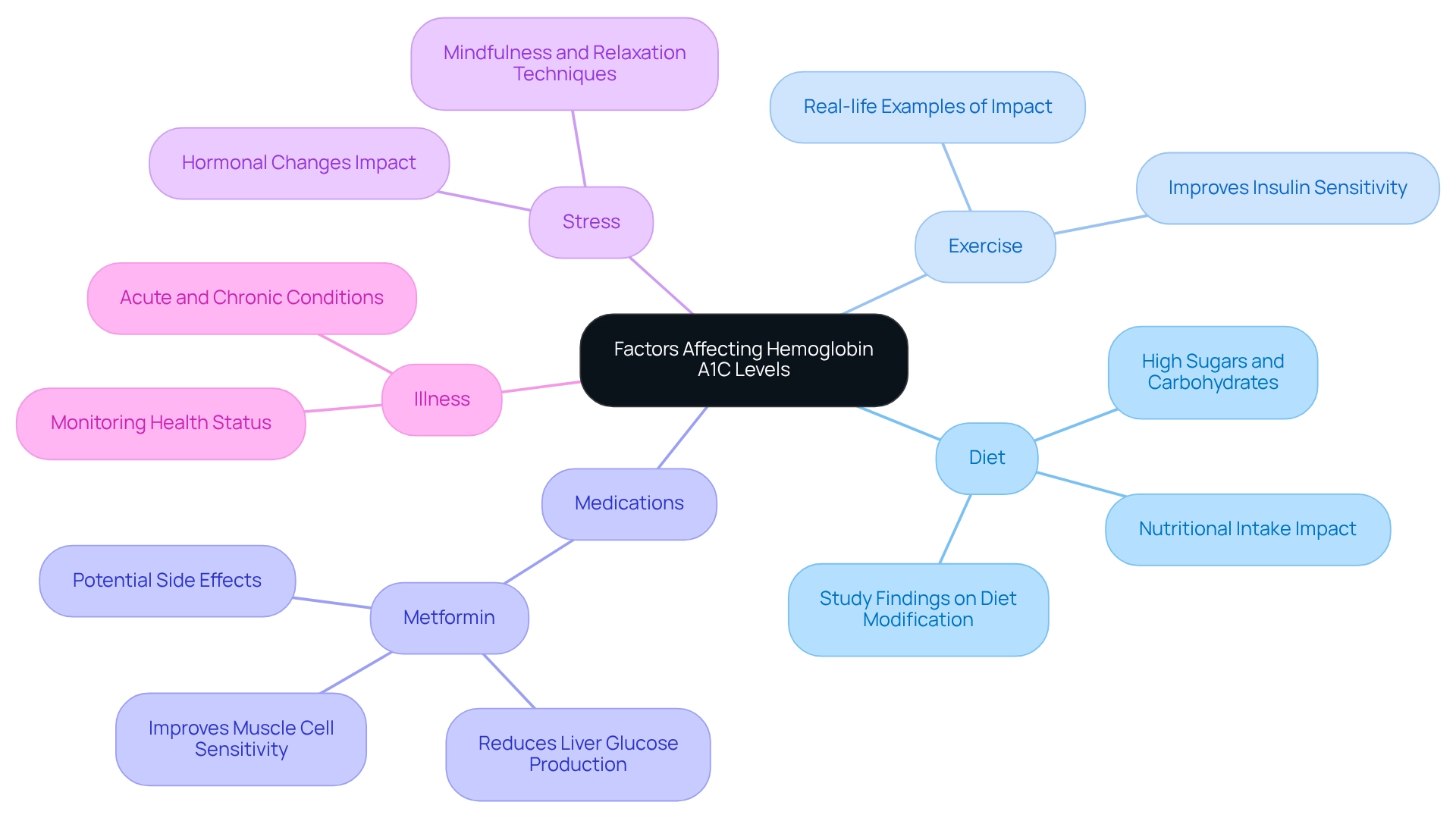Overview
Managing hemoglobin A1C can feel overwhelming, but together, we can achieve your goals. To help lower your A1C, consider implementing some lifestyle changes. Adopting a balanced diet, engaging in regular exercise, managing stress, and collaborating with healthcare providers for personalized treatment plans can make a significant difference.
These strategies not only improve insulin sensitivity but also reduce blood sugar levels, leading to better long-term health outcomes. It’s important to recognize that a holistic approach to diabetes management can truly enhance your well-being. Remember, you’re not alone in this journey; we’re here for you every step of the way.
Take a moment to reflect: What changes can you start making today? Together, we can navigate this path toward healthier living and brighter days ahead.
Introduction
In the journey toward managing diabetes, understanding Hemoglobin A1C (HbA1C) levels is essential for not just effective management but also for preventing complications. This important blood test reflects average blood sugar levels over the past two to three months and serves as a key indicator of long-term glucose control.
With rising statistics highlighting the increasing costs of diabetes and its associated health risks—such as cardiovascular disease and vision impairment—the importance of monitoring A1C levels truly cannot be overstated. Have you considered how these levels might impact your overall health?
By exploring the factors that influence HbA1C and implementing meaningful lifestyle changes, you can take significant steps toward better health outcomes. Together, let’s delve into the intricacies of HbA1C, examining its implications for diabetes management while offering practical strategies for improvement that resonate with your experiences.
Understanding Hemoglobin A1C: What It Is and Why It Matters
Hemoglobin A1C (HbA1C) is a vital blood test that helps you understand your average blood sugar levels over the past two to three months. This test serves as a crucial indicator of how well your body manages glucose. Knowing your A1C value is essential for diagnosing and monitoring blood sugar levels, as it offers valuable insights into long-term glucose control. Typically, a normal A1C value is below 5.7%.
If your levels fall between 5.7% and 6.4%, this indicates prediabetes, while an A1C of 6.5% or higher suggests diabetes. Understanding your A1C values is key to evaluating your risk for diabetes-related complications, such as cardiovascular disease and vision impairment, which affect many individuals. Did you know that diabetes is the leading cause of new blindness cases among adults aged 18–64? Approximately 10.1% of adults report severe vision difficulties or blindness. This statistic underscores the urgent need for effective management strategies to prevent such complications.
Regular monitoring of your A1C levels is crucial for managing blood sugar conditions effectively. It’s also essential for learning how to lower hemoglobin A1C, which can lead to improved overall health. Recent statistics show that the direct projected costs associated with diabetes-related issues have surged from $227 billion in 2012 to $307 billion in 2022, highlighting the growing impact of this condition on public health. Many individuals are discovering how to lower hemoglobin A1C through lifestyle changes and medical treatments, including Minimal’s weight management medications.
These medications not only help reduce blood sugar levels in those with type 2 diabetes but also guide you on how to lower hemoglobin A1C while aiding in weight management by boosting insulin sensitivity. They can be taken with or without insulin, lower the risk of heart disease and other diabetic complications, and improve long-term A1C values for better glucose management. However, it’s important to consider potential side effects, such as stomach discomfort, decreased vitamin B12 levels with long-term use, and the rare but serious risk of lactic acidosis if not used correctly.
As we approach 2025, average A1C measurements vary by age group, with younger populations generally showing lower figures compared to older adults. This trend highlights the importance of early intervention and education in managing blood sugar conditions. Experts consistently emphasize that maintaining normal A1C values is crucial for preventing long-term health issues.
Dr. Chance Miller shares, “Clients appreciate the personalized attention from a dedicated care team, which includes physicians like Dr. Chance Miller, who emphasize transformative care.”
It’s also essential to recognize that various conditions can affect the accuracy of the HbA1c test. Therefore, using NGSP-approved methods is necessary to ensure reliable measurements. Engaging actively with your healthcare provider to tailor effective treatment plans is vital. Remember, together, we can achieve your goals for better health.
Factors Affecting Hemoglobin A1C Levels: What You Need to Know
Several key factors significantly influence hemoglobin A1C values, which are crucial for effective diabetes management.
-
Diet: A diet high in sugars and carbohydrates can lead to increased blood sugar levels, subsequently raising A1C. It’s important to recognize how dietary choices play a crucial role in glycemic control. Many individuals experience significant changes in A1C values based on their nutritional intake. A recent study assessing 24-hour glucose readings through a continuous glucose monitor over 14 days uncovered important findings regarding how to lower hemoglobin A1C by modifying diet.
-
Participating in consistent exercise is another key aspect of lowering hemoglobin A1C, as it improves insulin sensitivity. Real-life examples demonstrate that individuals who incorporate consistent physical activity into their routines often discover how to lower their hemoglobin A1C readings significantly. Enhancing the lives of those impacted by this condition is vital. Charles “Chuck” Henderson, CEO, emphasizes the significance of reliable support in managing this health issue.
-
Medications prescribed for managing diabetes can directly influence blood glucose control and are essential for learning how to lower hemoglobin A1C outcomes. For instance, Metformin is FDA-approved to assist adults with type 2 diabetes in controlling blood glucose levels when paired with diet and exercise. While not FDA-approved for weight loss, many leading obesity specialists prescribe it off-label, believing it can aid weight loss by regulating insulin response and curbing cravings. Metformin functions by reducing liver glucose production and improving muscle cell responsiveness to insulin. It is typically taken by mouth, either with or after meals to minimize the chance of stomach upset. However, potential side effects may include stomach discomfort such as nausea or gas, possible diarrhea or loose stools, decreased vitamin B12 levels with long-term use, a metallic taste in the mouth, and rare but serious lactic acidosis if not used properly. Understanding how to lower hemoglobin A1C by grasping the effect of these medications, including Metformin’s capacity to reduce liver glucose production and improve muscle cell sensitivity to insulin, is essential for optimizing treatment strategies.
-
Stress: Chronic stress can lead to hormonal changes that raise blood glucose levels, thereby increasing A1C. Managing stress through mindfulness and relaxation techniques can be beneficial for maintaining stable blood glucose levels.
-
Illness: Both acute and chronic conditions can disrupt normal blood glucose regulation, leading to fluctuations in A1C readings. Monitoring health status and addressing any underlying conditions is essential for effective A1C management.
Additionally, it is crucial to note that among adults with diagnosed blood sugar issues, 47.4% had an A1C value of 7.0% or higher, indicating poor blood sugar control. Furthermore, 39.5% of adults with diabetes had a non-HDL measurement of 130 mg/dL or greater, emphasizing the relationship between diet, overall health, and A1C readings.
By comprehending these factors, including the influence of Metformin, individuals can better understand how to lower hemoglobin A1C, creating a pathway for improved health outcomes. Remember, we’re here for you, and together, we can achieve your goals.
Lifestyle Changes to Lower A1C: Effective Strategies for Improvement
To effectively reduce your A1C values, we encourage you to consider implementing some lifestyle changes that can be supported by Minimal’s personalized weight loss solutions and holistic health treatments.
Regular Exercise: Are you ready to take a step towards better health? Aim for at least 150 minutes of moderate aerobic activity each week, such as brisk walking, cycling, or swimming. Incorporating strength training exercises at least twice a week can further enhance your results. Research shows that consistent physical activity can effectively demonstrate how to lower hemoglobin A1C values, with some people seeing enhancements of up to 1% following regular exercise routines. The American Diabetes Association states that meeting physical activity guidelines has been associated with a 40% decrease in cardiovascular mortality, highlighting the importance of exercise not just for A1C management but overall health. At Minimal, we offer personalized fitness plans that can help you stay motivated and on track with your exercise goals.
Healthy Eating: What if you could nourish your body with the right foods? Focus on a balanced diet rich in whole foods, including a variety of vegetables, lean proteins, and whole grains. Limiting processed foods, added sugars, and refined carbohydrates is crucial. Research indicates that dietary modifications can teach individuals how to lower hemoglobin A1C, with those who embrace healthier eating habits frequently attaining reductions of 0.5% to 2% over several months. Minimal provides nutrition guidance tailored to your individual needs, helping you make sustainable dietary choices.
Weight Management: Have you considered how small changes can lead to big results? Shedding even a minor percentage of your body weight can greatly affect your A1C values. For example, a loss of merely 5-10% in weight can result in a decrease in A1C readings by roughly 0.5% to 1%. Aim for gradual weight loss through a combination of diet and exercise, as this approach is more sustainable and effective in the long run. Minimal’s holistic approach includes weight loss prescriptions that can support your journey toward achieving a healthier weight.
Stress Management: Are you feeling overwhelmed? Practicing stress-relief methods like yoga, meditation, or deep-breathing exercises can assist in reducing blood glucose. Chronic stress is associated with increased blood glucose, so discovering effective methods to manage stress is crucial for sustaining healthy A1C levels. Additionally, regular exercise has been shown to alleviate symptoms of depression and anxiety, improving overall quality of life for individuals with type 2 diabetes. Minimal offers alternative treatments that can assist in stress management and promote overall well-being.
Adequate Sleep: Are you prioritizing your sleep? Ensure you get enough quality sleep, as poor rest can negatively impact blood glucose control. Research has indicated that people who value sleep frequently achieve improved blood sugar control, which can lead to reduced A1C values. Minimal highlights the significance of comprehensive health, which encompasses sleep hygiene as an essential part of overall wellness.
By applying these strategies, backed by Minimal’s tailored services, you can learn how to lower hemoglobin A1C readings significantly over time. Real-world examples show that individuals who have successfully adopted these lifestyle changes report not only how to lower hemoglobin A1C but also enhanced overall well-being. For instance, a recent case study revealed that participants who combined regular exercise with dietary modifications saw an average A1C reduction of 1.5% within six months.
Furthermore, it’s important to note that women with type 2 conditions may experience more pronounced exercise impairments in cardiorespiratory fitness than men, indicating the need for tailored exercise recommendations. For adults over 40 with cardiovascular disease risk factors or over 30 with long-term diabetes, maximal graded exercise stress testing may be indicated to ensure safe and effective exercise regimens. By committing to these effective lifestyle changes, and with the support of Minimal, you can take meaningful steps toward better health.
Dietary Modifications: Foods to Embrace and Avoid for Lower A1C
To effectively manage your A1C levels through dietary choices, consider these compassionate recommendations, which can be complemented by the personalized weight loss solutions offered by Minimal:
Foods to Embrace:
- Non-Starchy Vegetables: Aim to fill half your plate with a variety of vegetables such as spinach, broccoli, and bell peppers. These nutrient-rich choices are low in calories and carbohydrates, making them perfect for blood glucose management.
- Whole Grains: Opt for whole grains like brown rice, quinoa, and whole-wheat bread instead of refined grains. Studies suggest that whole grains can enhance insulin sensitivity and reduce A1C values.
- Lean Proteins: Incorporate lean protein sources such as chicken, fish, beans, and legumes. These foods assist in preserving muscle mass while enhancing fullness, which can support weight control and blood glucose regulation.
- Healthy Fats: Include moderate amounts of healthy fats from avocados, nuts, and olive oil. These fats can enhance heart wellness and may also contribute to stabilizing blood glucose.
- High-Fiber Foods: Strive for a daily intake of 25-30 grams of fiber from fruits, vegetables, and whole grains. High-fiber diets have been proven to be effective for those looking to learn how to lower hemoglobin A1C values significantly, as fiber delays the uptake of glucose and helps maintain stable blood glucose readings. A case study involving individuals who adopted a high-fiber diet showed a reduction in A1C levels by an average of 1.5% over six months.
Foods to Avoid:
- Sugary Beverages: Limit consumption of sodas, sweetened teas, and fruit juices, which can cause rapid spikes in blood sugar.
- Refined Carbohydrates: Steer clear of white bread, pastries, and other processed foods high in sugar. These items can result in heightened insulin resistance and elevated A1C values.
- High-Fat Meats: Reduce intake of fatty cuts of meat and processed meats, which can contribute to inflammation and negatively impact insulin sensitivity.
- Trans Fats: Avoid fried foods and baked goods made with partially hydrogenated oils, as these unhealthy fats can exacerbate insulin resistance and increase the risk of heart disease.
Making these dietary changes can greatly assist you in understanding how to lower hemoglobin A1C values. Additionally, it is important to note that understanding how to lower hemoglobin A1C levels generally takes about three months, depending on initial A1C levels, consistency in management, and individual health conditions. Close monitoring by a healthcare professional is essential during this process.
Expert views highlight that consistent dietary modifications, overseen by healthcare professionals, are essential for effective management of the condition. As Charles “Chuck” Henderson, the ADA’s chief executive officer, states, “Enhancing the lives of individuals impacted by this condition is a key part of the ADA’s mission.” The ADA offers the trusted support needed for people living with diabetes and those caring for them to manage the disease and thrive until we find a cure.
By adopting these strategies and seeking assistance from Minimal, which provides access to effective health solutions beginning at $49 for the first month, you can make significant progress toward better health and enhanced A1C results. Together, we can achieve your goals.
The Role of Exercise: How Physical Activity Impacts A1C Levels
Physical activity plays a vital role in understanding how to lower hemoglobin A1C values, and recognizing its diverse benefits can empower individuals on their health journey. How does exercise contribute to better glycemic control? Let’s explore this together, especially within the holistic wellness programs offered at Minimal.
Improved Insulin Sensitivity: Regular physical activity enhances the body’s ability to utilize insulin effectively, leading to lower blood sugar levels. This is particularly important for those managing diabetes. Our weight loss prescriptions and personalized fitness plans can support you in learning how to lower hemoglobin A1C.
Weight Management: Physical activity is essential in understanding how to lower hemoglobin A1C and maintaining a healthy weight, both critical for regulating A1C values. Research indicates that weight loss significantly improves glycemic management, helping many individuals understand how to lower hemoglobin A1C as they shed excess pounds with our customized fitness and nutrition support.
Types of Exercise:
- Aerobic Exercise: Activities like walking, running, swimming, and cycling effectively lower blood sugar levels. Did you know that each increase in metabolic equivalent (MET) of fitness correlates with a 15% to 20% reduction in cardiovascular disease mortality risk? This highlights the importance of aerobic activities in our fitness training programs.
- Resistance Training: Incorporating weight lifting or bodyweight exercises builds muscle mass and enhances insulin sensitivity. This dual benefit makes resistance training a powerful ally in managing blood sugar. Our trainers are here to provide expert guidance to help you integrate this into your routine.
- Flexibility and Balance: Practices such as yoga and tai chi contribute to overall health and stress reduction, indirectly supporting glycemic management. While more research is needed to fully understand their impact, these activities can enhance quality of life for individuals with diabetes and are part of our holistic approach, which includes breathwork and acupuncture.
- High-Intensity Interval Exercise (HIIE): A case study focusing on HIIT training has shown significant improvements in glycemic control and fitness for adults with Type 2 Diabetes (T2D). This training involves short bursts of intense aerobic activity followed by recovery periods, resulting in better body composition and enhanced insulin sensitivity compared to continuous walking.
For optimal results, aim for a balanced routine that includes both aerobic and resistance training, as recommended in our personalized health programs. Even brief periods of activity can effectively lower blood sugar, so seek opportunities to incorporate movement into your daily life. Real-life examples illustrate how to lower hemoglobin A1C; individuals who maintain regular exercise routines often experience notable improvements in their A1C values, underscoring the essential role of physical activity in managing blood sugar.
As Dr. Reshmi Srinath wisely states, “Physical activity is more likely to become a lifestyle modification when derived from autonomous motivation rather than from guilt or pressure.” Together, we can foster a lifestyle that embraces regular exercise, supported by Minimal’s comprehensive wellness services, including continuous glucose monitoring, leading to sustainable health improvements and enhanced overall well-being.
Monitoring and Medical Support: Partnering with Healthcare Providers for Better A1C Management
Consistent tracking of your A1C values is crucial for managing blood sugar issues effectively. Understanding how to lower hemoglobin A1C becomes even more important considering that the total estimated expenses for diagnosed blood sugar conditions in the U.S. reached $413 billion in 2022. Here’s how you can collaborate effectively with your healthcare provider:
- Schedule Regular Check-Ups: Work together with your healthcare team to establish a testing schedule for your A1C levels, typically recommended every three to six months. This frequency allows for timely adjustments to your management plan based on your current health status. Remember, the accuracy of the HbA1c test can vary between laboratories, so using NGSP-approved methods is essential for reliable results.
- Discuss Treatment Options: Keep the lines of communication open about your lifestyle changes and any challenges you face. This dialogue enables your provider to tailor your treatment plan, ensuring it aligns with your personal health goals and circumstances, including how to lower hemoglobin A1C. As highlighted in the case study named “Enhancing Healthcare Team Outcomes,” understanding HbA1c measurements among clinicians is vital for assessing treatment success and promoting collaboration in managing blood sugar-related care.
- Utilize Technology: Embrace advancements in blood sugar management technology, such as continuous glucose monitors (CGMs). These devices provide real-time tracking of your blood sugar levels, offering valuable insights that can enhance your A1C management.
- Education and Resources: Take advantage of the educational materials and resources provided by your healthcare team. Understanding your condition and the strategies available for management, including how to lower hemoglobin A1C, can empower you to make informed decisions about your health.
- Support Groups: Consider participating in support groups for those managing blood sugar levels. These communities can provide additional motivation and a platform to share experiences with others facing similar challenges. The encouragement and practical advice from these groups can significantly enhance your overall management strategy.
As Charles “Chuck” Henderson, the ADA’s chief executive officer, states, “Enhancing the lives of individuals impacted by this condition is a key part of the ADA’s mission.” By actively participating in your healthcare journey and utilizing available resources, you can learn how to lower hemoglobin A1C and improve your overall health outcomes. Remember, together, we can achieve your goals.
Key Takeaways: Your Path to Lowering Hemoglobin A1C
To effectively lower your hemoglobin A1C levels, consider these key strategies:
- Understand A1C: It’s important to recognize that hemoglobin A1C is a crucial marker for long-term blood sugar control, reflecting your average blood glucose levels over the past two to three months. Awareness of its significance is vital for effective diabetes management. How does understanding this impact your journey?
- Identify Influencing Factors: A1C readings are influenced by various elements such as diet, physical activity, stress, and overall health. Comprehending these factors can assist you in tailoring your approach to managing your metrics more effectively.
- Implement Lifestyle Changes: Adopting a healthier lifestyle is essential. Consistent physical activity, proper nutrition, and effective weight control can greatly influence your A1C readings. At Minimal, we offer personalized coaching that focuses on these aspects, ensuring you have the support needed to achieve your weight loss goals. Aim for at least 150 minutes of moderate aerobic activity each week, as this can enhance insulin sensitivity and aid in weight control.
- Make Informed Dietary Choices: Focus on whole foods, such as fruits, vegetables, whole grains, and lean proteins, while minimizing processed sweeteners and refined carbohydrates. This dietary change can lead to improved blood sugar management and reduced A1C readings. Our holistic approach at Minimal emphasizes the importance of nutrition in your health journey. Together, we can make these choices easier.
- Engage in Regular Physical Activity: Consistent physical activity not only helps manage weight but also improves insulin sensitivity. Including strength training and aerobic exercises in your routine can produce considerable advantages for your A1C readings. Our personalized coaching programs at Minimal are designed to help you stay active and motivated. Remember, every little step counts!
- Partner with Healthcare Providers: Regular monitoring and support from healthcare professionals are crucial. As Dr. Chance Miller emphasizes, “Clients appreciate the personalized attention from a dedicated care team, which includes physicians like Dr. Chance Miller, who emphasize transformative care.” Collaborate with your care team at Minimal to develop a personalized plan that addresses your unique health needs and goals. This partnership can enhance adherence to treatment and improve overall outcomes.
By following these strategies, you can take proactive measures toward managing your health and discovering how to lower hemoglobin A1C. Recent trends indicate that comprehensive strategies for managing the condition, including personalized treatment plans, are essential for success. For instance, studies show that simplifying treatment regimens can improve adherence and reduce complications, particularly in older adults who may be at risk for hypoglycemia.
As global diabetes cases are projected to rise from 529 million in 2021 to 1.3 billion by 2050, understanding and managing A1C levels will become increasingly important for maintaining quality of life. Remember, we’re here for you every step of the way.
Conclusion
Understanding and managing Hemoglobin A1C (HbA1C) levels is vital for individuals navigating the challenges of diabetes. This important marker reflects average blood sugar levels over the past two to three months, serving as a crucial indicator of long-term glucose control. Have you been monitoring your A1C levels regularly? Recognizing the factors that influence these readings—such as diet, exercise, stress, and medications—can empower you to tailor your diabetes management strategies effectively.
Implementing lifestyle changes is essential for lowering A1C levels. Regular physical activity, balanced nutrition, and effective weight management have been shown to lead to significant improvements in health outcomes. Consider engaging in at least 150 minutes of moderate exercise weekly and making informed dietary choices—these practical strategies can positively impact your A1C levels. Remember, partnering with healthcare providers for personalized support and guidance is key to your success.
As the global diabetes epidemic continues to rise, understanding and managing A1C levels will be increasingly crucial for maintaining a healthy quality of life. By adopting a proactive approach that includes lifestyle modifications and active collaboration with healthcare professionals, you can make meaningful strides toward better health and improved diabetes management. Together, we can achieve your goals, enhancing your personal well-being while contributing to the broader goal of reducing the impact of diabetes on public health.
Frequently Asked Questions
What is Hemoglobin A1C (HbA1C) and why is it important?
Hemoglobin A1C (HbA1C) is a blood test that measures your average blood sugar levels over the past two to three months. It is crucial for diagnosing and monitoring blood sugar levels, providing insights into long-term glucose control.
What do different A1C values indicate?
A normal A1C value is below 5.7%. Values between 5.7% and 6.4% indicate prediabetes, while an A1C of 6.5% or higher suggests diabetes. Understanding these values is key to evaluating the risk of diabetes-related complications.
What are the potential complications of unmanaged diabetes?
Unmanaged diabetes can lead to serious complications such as cardiovascular disease and vision impairment. Diabetes is a leading cause of new blindness cases among adults aged 18–64.
How has the economic impact of diabetes changed recently?
The direct projected costs associated with diabetes-related issues have increased from $227 billion in 2012 to $307 billion in 2022, highlighting the growing public health impact of this condition.
What strategies can help lower hemoglobin A1C levels?
Strategies for lowering hemoglobin A1C include lifestyle changes such as a healthier diet, consistent exercise, and the use of medications like Metformin, which can help manage blood sugar levels and improve insulin sensitivity.
What are the potential side effects of medications like Metformin?
Potential side effects of Metformin may include stomach discomfort, decreased vitamin B12 levels with long-term use, a metallic taste in the mouth, and the rare but serious risk of lactic acidosis if not used correctly.
How do age groups affect average A1C measurements?
Average A1C measurements tend to vary by age group, with younger populations generally showing lower figures compared to older adults, emphasizing the importance of early intervention and education in managing blood sugar conditions.
What factors can influence hemoglobin A1C values?
Key factors that influence hemoglobin A1C values include diet, exercise, medications, stress, and illness. Each of these factors plays a significant role in effective diabetes management.
Why is it important to engage with healthcare providers regarding A1C management?
Engaging with healthcare providers is vital for tailoring effective treatment plans and ensuring reliable measurements of A1C, which is essential for achieving better health outcomes.


















